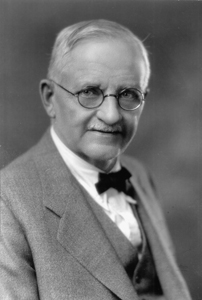
Bohumil Shimek
1861-1937

Shimek was born in Shueyville, Iowa, June 25, 1861, to Maria Theresa and Francis Joseph Shimek, refugees from the present day Czech Republic. In 1878, he began studying civil engineering at the University of Iowa and graduated in 1883. For the next two years Shimek was employed as a railroad and county surveyor in Johnson County Iowa, followed by three years teaching science at Iowa City High School. In 1888, he taught zoology at the University of Nebraska for two years before becoming a Botany instructor at the University of Iowa where he remained until his retirement in 1932. At the University of Iowa, Shimek founded and directed the Iowa Lakeside Laboratory, and served as curator of the herbarium.
Academically Shimek's career spanned several disciplines and many of his findings are utilized today. In zoology his research primarily focused on fossilized snails which led to studies of Iowa Pleistocene geology. One of Shimek's best known achievements was defining the term Nebraskan (a stratographic term for a layer under the Aftonian interglacial deposits) and identifying that loess is a product of wind rather than water. During his tenure at the University of Iowa, Shimek is estimated to have collected around 200,000 specimens of vascular plants, 5,000 bryophytes, and 2,400,000 specimens of mollusks. Currently the bulk of these collections are located at the Smithsonian Institution and the University of Iowa-Iowa State University herbarium; other specimens are located in several different collections including Pleistocene mammals in the University of Iowa Paleontology Repository.
Although Shimek spent most of his life in the United States, he was involved in the independence of Czechoslovakia and served as an exchange professor of botany at the Charles University of Prague in 1914. During this time Shimek befriended Tomas Masaryk, the first president of Czechoslovakia. In 1914, when Austria invaded Czechoslovakia Shimek fled with Masaryk and later assisted him during his exile in the United States in 1918. Later Shimek was awarded a Ph.D. degree, honoris causa, from the Charles University of Prague for his scientific contributions and the Czech medal of honor in 1927. Personally, Shimek was married to Anna Konvalinka, also of Czech descent, and had five children, after Anna died in 1922, he married Margaret Meerdick. Bohumil Shimek died in Iowa City on January 30, 1937 at the age of 75.
Bohumil Shimek was a member of the Iowa Academy of Science-president in 1904, Botanical Society of America-also served as president, International Scientific Congress-chairman of the geological section, Ecological Society, Washington Academy of Science, Iowa State Geological Board, Sigma Xi, and the Isaac Walton League. He was a fellow of the American Association for the Advancement of Science, Geological Society of America, Botanical Society of Bohemia, and Natural History Society of Prague. His recognition continues today through the Bohumil Shimek Elementary School in Iowa City, the Bohumil Shimek Environmental Educator Award, Shimek State Forest-located in Southeastern Iowa, and the snail species Discus shimekii
"A knowledge of plants" He said "will enable us to perpetuate and utilize that which is useful, and to protect ourselves against that which is harmful. It will convince us that we must concern ourselves not only with immediate profit but with future consequence."
Scan of Shimek's Original Labels
For more information on Bohumil Shimek please visit the following sites:
http://www.iacad.org/bios/shimek.html
http://www.nature.org/wherewework/northamerica/states/iowa/science/art2205.html
http://www.lib.uiowa.edu/spec-coll/Archives/guides/RG99.0036.htm
For an additional picture of Bohumil Shimek please use the links below:
http://www.cgrer.uiowa.edu/herbarium/Images/LargeImagesText/Shimek.htm